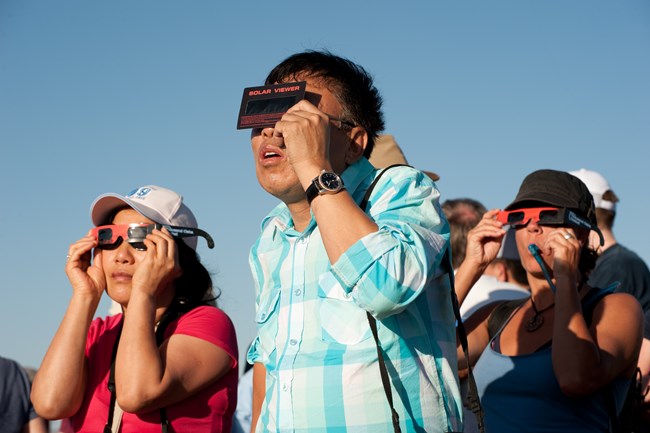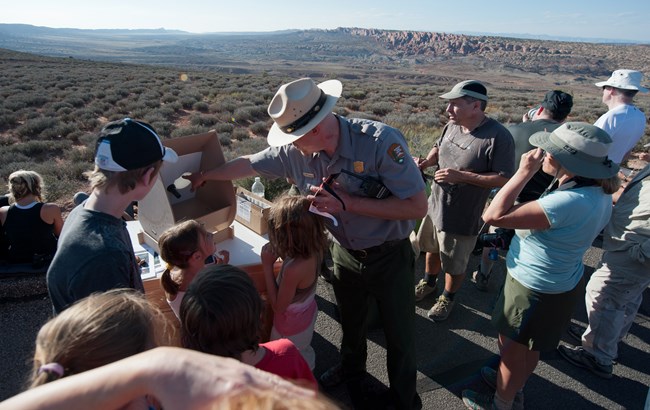Last updated: July 25, 2023
Article
How to View a Solar Eclipse Safely

NPS Photos by Neal Herbert, John Tobiason, and Erin Whittaker
Planning to view a solar eclipse? Learn more about the different types of eclipses, get tips for planning a trip for an eclipse, find information about safely viewing eclipses, and get answers to some of our most frequently asked questions about eclipse viewing.
What Are The Different Types Of Solar Eclipses?
Partial Solar Eclipse
A partial solar eclipse occurs when the moon blocks part of the sun's bright face. Some viewers in the Continental United States will experience a total solar eclipse, but many will experience a partial eclipse.
Looking directly at the sun without a solar filter is always unsafe during a partial eclipse.
Total Solar Eclipse
A total solar eclipse occurs when the moon completely blocks the sun's bright face, also known as totality, and day momentarily turns into night. Outside the path of totality, viewers in the continental United States will experience a partial eclipse.
A total solar eclipse is the only type of solar eclipse where viewers can momentarily remove their solar filters (which are not the same as regular sunglasses) for the brief period of time when the moon completely blocks the sun.
Looking directly at the sun is unsafe except during the total phase of a solar eclipse which lasts 2-4 minutes depending on your location in the viewing path. This will only happen in certain areas, learn which parks are in the path of totality.
Annular Solar Eclipse
An annular solar eclipse occurs when the moon passes between the sun and the Earth. The moon's disk does not fully cover the sun and a ring of bright sunlight, or annulus, is seen. This "Ring of Fire" is visible around the moon during the maximum phase of this type of eclipse. Learn what parks will be able to view the upcoming annular eclipse.
It is never safe to look at the sun during an annular eclipse without special purpose solar filters.
Do I Need To Plan Ahead?
Parks are planning for increased visitation if they are within the path of an upcoming eclipse. Be prepared for the eclipse by:
- Trip planning – Use the Trip Planning Guide to prepare for your visit to the park. Check the park website for more information on planned eclipse events and important travel information such as changes to park operating hours and availability of services like food, water, and bathrooms.
- Bring your own solar filter – Some parks may or may not have safe eclipse viewing materials for visitors. Consider bringing enough solar glasses or filters for your group. Read our section on eye safety to ensure you have good quality solar filters.
- Plan for extra travel time – High volume traffic to the park is likely. Plan for extra travel time to get to the park and to find parking which will be limited. Parks may adjust the traffic flow in the park and may have limited parking options for the eclipse. Check the park's event page for travel information before you go.
How Do I View An Eclipse Safely?

NPS Photo / Neal Herbert
The only safe way to look directly at the sun during an eclipse is through special-purpose solar filters, like eclipse glasses or handheld solar viewers.
Remember the only safe time to look at the sun without solar filters is during the 2-4 minutes of total eclipse. It is never safe to look at the sun without solar filters during any other phases of the eclipse, or if you are viewing a partial or annular eclipse.
Homemade filters or ordinary sunglasses, even very dark ones, are not safe for looking at the sun.
Solar filters should have:
- An ISO 12312-2:2015 certification
- The manufacturer's name and address printed somewhere on the product
Do not use solar filters that are:
- Missing ISO certification information
- Torn, scratched, or have wrinkled lenses
- Coming loose from their frames
- Made before 2015
Using Eclipse Filters Correctly
Read and follow the instructions printed on or packaged with the solar filter. Always supervise children using solar filters. To look at the sun during the eclipse, follow these general steps:
- Inspect your solar filter before use - if scratched or damaged, discard it and find a new filter. If one is not available, read our section on Eclipse Viewing Without a Solar Filter.
- Before looking at the sun, put on your eclipse glasses or hold your handheld solar viewer up to your eyes.
- After viewing the sun with your solar filter, turn away from the sun before removing. Do not remove your solar filter while looking at the sun.
- If you are within the path of totality, you can remove your solar filter only when the moon completely covers the sun's face and it suddenly gets very dark. As soon as the bright sun begins to reappear, reapply your solar viewer to glance at the remaining partial phases.
This document does not constitute medical advice. Readers with questions should contact a qualified eye-care professional.

NPS Photo / Neal Herbert
Eclipse Viewing With Optical Devices
Do not look at the uneclipsed or partially eclipsed sun through an unfiltered camera, telescope, binoculars, or other optical device. Similarly, do not look at the sun through a camera, telescope, binoculars or any other optical device while using your eclipse glasses or hand-held solar vieiwer - the concentrated solar rays will damage the filter and enter your eye(s), causing serious injury.
Eclipse Viewing Without a Solar Filter
An alternative method for safely viewing the partially eclipsed sun is pin-hole projection. For example:
Cross the outstretched, slightly open fingers of one hand over the outstretched, slightly open fingers of the other hand. With your back to the sun, look at your hands' shadow on the ground. The little spaces between your fingers will project a grid of small images on the ground, showing the sun as a crescent during the partial phases of the eclipse.
NASA also has instructions on how to make a pin-hole projector.
Frequently Asked Questions
Seek expert advice from an astronomer before using any solar filter with a camera, telescope, binoculars, or any other optical device.
